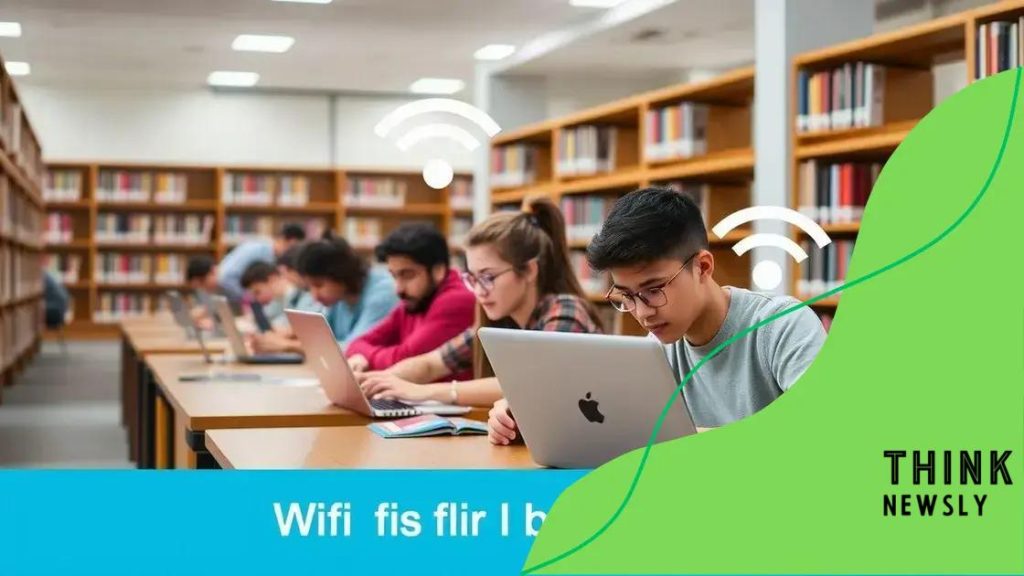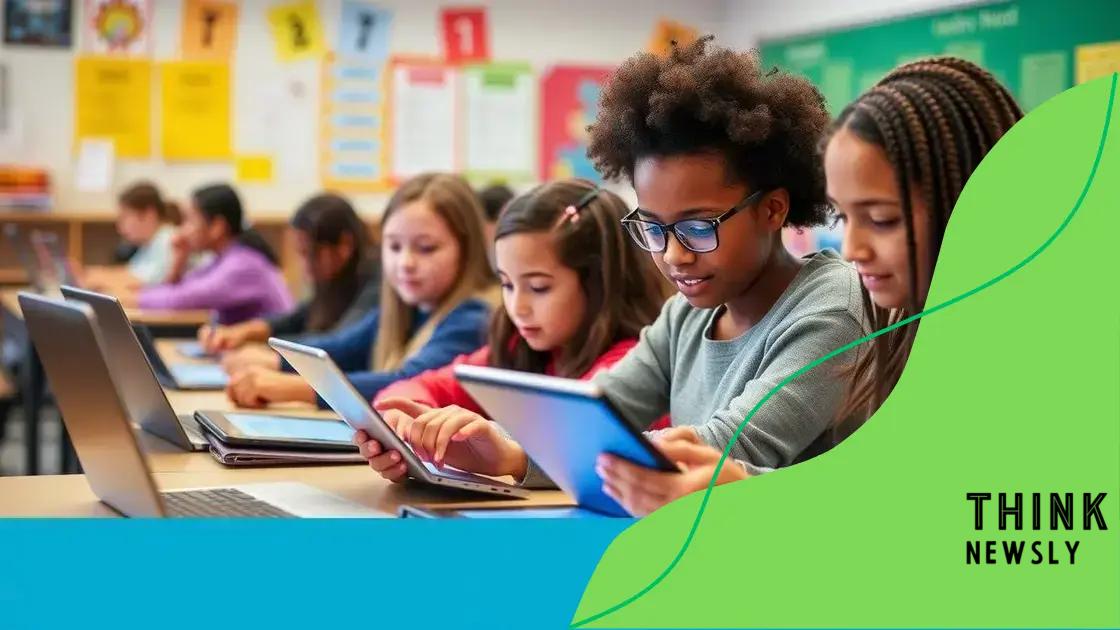School Wi-Fi policies updated: what you need to know

Anúncios
Updated school Wi-Fi policies improve student learning and engagement by enhancing internet access, ensuring security, and involving parents to create a better educational environment.
School Wi-Fi policies updated are crucial for enhancing educational environments. These changes can significantly impact how students connect and learn. Curious about what’s different? Let’s dive in!
Anúncios
Understanding the need for updated Wi-Fi policies
Understanding the need for updated Wi-Fi policies is critical for schools today. As technology evolves, so does the way students access information and connect with each other.
The role of technology in education
Technology plays a significant role in modern education. With a reliable Wi-Fi connection, students can:
- Access online resources and research materials
- Engage in virtual learning opportunities
- Collaborate in real-time with peers
These factors stress the necessity for having effective Wi-Fi policies in place.
Anúncios
Understanding the challenges
Despite the advantages, schools face numerous challenges. Security concerns, bandwidth limitations, and user management are common issues that require innovative solutions.
Many students use personal devices, which can create security vulnerabilities. Ensuring a safe browsing environment is paramount. Furthermore, with increased usage, schools often need higher bandwidth to support high-demand applications.
Therefore, updating Wi-Fi policies is not just about access; it’s about creating a safe, efficient, and inclusive environment for learning.
Key changes in school Wi-Fi policies
When discussing key changes in school Wi-Fi policies, it’s essential to recognize how these updates can enhance student experiences. These policies aim to create a more secure and efficient digital environment.
Enhanced Security Measures
One significant change is the introduction of stronger security protocols. Schools are now adopting:
- Encryption to protect sensitive data
- Filtered internet access to restrict harmful content
- Regular audits of network activity for suspicious behavior
These steps help safeguard students while they use the school’s Wi-Fi. Additionally, it reassures parents about their children’s online safety.
Increased Bandwidth Allocation
Another important update is the adjustment of bandwidth allocations. With more devices connected to the network, schools must ensure that:
- Students have fast and reliable internet access for research
- Online learning tools function smoothly
- Streaming and interactive sessions are supported without lag
These changes are crucial as they accommodate the growing reliance on technology in classrooms.
Furthermore, schools are implementing policies that promote responsible use of Wi-Fi. This includes guidelines on appropriate online behavior and consequences for misuse. By teaching students about digital citizenship, schools encourage them to interact positively online.
Impact on student learning and engagement

The impact on student learning and engagement from updated Wi-Fi policies cannot be overstated. These changes enable students to access resources quickly and interactively.
Positive Learning Outcomes
When schools improve their Wi-Fi connection, the benefits are significant. Students can:
- Participate in immersive learning experiences.
- Utilize online platforms for assignments and projects.
- Engage in collaborative activities with classmates.
This creates a dynamic classroom environment where learning is enhanced through technology.
Boosting Student Engagement
Updated policies also encourage student engagement. With better connectivity, teachers can incorporate more technology in their lessons. For instance, lessons can include:
- Interactive quizzes that keep students involved.
- Multimedia presentations that appeal to diverse learning styles.
- Real-time feedback that motivates students to participate.
As a result, students feel more connected to what they are learning. They are not just passive recipients of information; they are active participants in their education.
Furthermore, fostering a sense of community plays a huge role. When students collaborate on projects using Wi-Fi, they build teamwork skills and friendships. This interaction is vital for their overall development.
Best practices for schools in implementing Wi-Fi updates
Implementing Wi-Fi updates in schools requires a strategic approach. Following best practices can ensure that these updates are effective and beneficial for all users.
Assess Current Needs
The first step is to assess the current internet usage and needs of the school. Identifying areas such as:
- The number of devices used by students and staff
- Current bandwidth usage
- Specific applications that need prioritization
Understanding these factors helps schools make informed decisions about upgrades.
Involve Stakeholders
Engaging stakeholders is crucial in the process. This includes:
- Teachers who will use the network for lessons
- Students who rely on the internet for learning
- IT staff who will maintain the system
Collecting input and feedback ensures that the updated policies meet everyone’s needs. It also promotes a sense of community as everyone feels involved in the changes.
Plan for Future Growth
Planning for the future is also important. This means choosing systems that can grow with the school. Considerations include:
- Scalable solutions that can accommodate more devices
- Regular reviews of network performance
- Training for staff on new technologies
This foresight helps schools avoid becoming outdated as technology advances.
Lastly, schools should continuously monitor the Wi-Fi environment. Regular assessments can identify potential issues before they disrupt learning. By staying proactive and adapting policies as needed, schools can create a robust and reliable digital learning space for students.
What parents should know about the new policies
When it comes to what parents should know about the new policies, awareness and understanding are key. It’s important for parents to be informed about the changes to Wi-Fi access and usage in schools.
Changes in Access
First and foremost, parents need to understand how Wi-Fi access might change for their children. New policies may include:
- Restricted access to certain websites to enhance safety.
- Increased filters to prevent distractions during school hours.
- Changes in the login process for student devices.
These changes aim to provide a safer and more focused learning environment.
Impact on Learning
Second, parents should be aware of the positive impacts that these policies can have on learning. With enhanced connectivity, students can:
- Engage more effectively with online resources.
- Participate in digital projects and collaborative assignments.
- Access educational apps that promote learning.
This means that as policies update, the range of tools and resources available will expand, benefiting students academically.
Parental Control and Involvement
Additionally, many schools will offer ways for parents to stay involved. This can include:
- Regular updates about internet policies from school administrations.
- Workshops on how to support children’s online learning at home.
- Tools to help parents monitor their child’s internet usage.
Such involvement helps ensure that parents are partners in their child’s education, promoting accountability and safety.
FAQ – Frequently Asked Questions about School Wi-Fi Policies
What are the main benefits of updated Wi-Fi policies for schools?
Updated Wi-Fi policies enhance internet access and security, providing a better learning environment for students and encouraging engagement.
How can parents stay informed about the new Wi-Fi policies?
Parents can stay informed through regular updates from schools, attending informational meetings, and engaging with other parents for shared insights.
What security measures are included in the new policies?
The new policies often include stronger filters to restrict harmful content, encryption for sensitive data, and regular audits of network activity.
How do these updates impact student learning?
These updates facilitate access to online resources, promote interactive learning, and support collaborative projects, ultimately enhancing educational outcomes.





